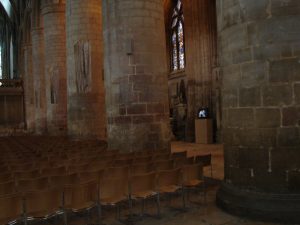 My third novel in the Lady Apollonia West Country Mysteries, Memento Mori, is set in Gloucester in 1392. In this posting, I would like to discuss the history of Gloucester from the departure of the Roman army in the 5th century until the time of Lady Apollonia’s adventure there. Although the Romans had occupied the part of Britain where the Dobunni, a Celtic tribe, had been located, there were few Celts left after the Roman departure to stop the Saxons from taking over the area.
My third novel in the Lady Apollonia West Country Mysteries, Memento Mori, is set in Gloucester in 1392. In this posting, I would like to discuss the history of Gloucester from the departure of the Roman army in the 5th century until the time of Lady Apollonia’s adventure there. Although the Romans had occupied the part of Britain where the Dobunni, a Celtic tribe, had been located, there were few Celts left after the Roman departure to stop the Saxons from taking over the area.
A decisive battle at Dyrham in 577 resulted in the capture of Gloucester, Cirencester, and Bath by the Hwicce, a subordinate tribe of the Mercian dynasty. A century later, King Osric of the Hwicce founded the abbey which appears in Memento Mori as the Abbey of Saint Peter. This foundation by Osric is mentioned in my blog post of March 1, 2017. The town was re-fortified and re-planned in the 10th century as part of the Kingdom of Mercia by Queen Aethelflaeda, daughter of Alfred the Great and the street plan of modern Gloucester was largely determined at that time. The last major king of the Saxon period, Edward the Confessor, used the great hall of the Royal Manor at Kingsholm to meet with his council putting Gloucester on a level with Winchester and London.
The Norman period brought change after 1066, but William the Conqueror continued the practice of sometimes meeting his Council in Gloucester. At such a gathering in 1085, he ordered the survey of the kingdom that came to be known as the Domesday Book. He also appointed Serlo of Bayeux as the abbot who was to restore the flagging fortunes of Saint Peter’s abbey. The picture above shows the Norman pillars in the nave of Gloucester Cathedral, a remnant of Serlo’s building program for the abbey.
King Henry I in 1155 granted a city charter to Gloucester which gave it a status like Westminster and London. The only English monarch since the Conquest to be crowned outside of Westminster was Henry III, crowned in Gloucester’s Abbey of Saint Peter in 1216. He was only nine when he became king but throughout his life, he was very supportive of friaries that were founded in Gloucester
The big event of the14th century was the burial of King Edward II at the Abbey of Saint Peter as I have discussed in my posting of March 9, 2017. His tomb brought pilgrim’s gifts, and royal funds to the abbey from his son, King Edward III, enabling the grand refurbishing of the abbey church it had become at the time of my novel and as it can be seen today.
By the time of my story, Gloucester was a port on the Severn River which had major trading connections with Bristol, with smaller market towns in the region and with South Wales. Ironworking and clothmaking were important to its economic base. My story mentions Gloucester’s Gild Hall which was a meeting place for guildsmen at the time.
For more on the medieval history of Gloucester, click on
http://www.british-history.ac.uk/vch/glos/vol4/pp13-18
Tags: Chaucer's England, historical fiction, medieval mysteries